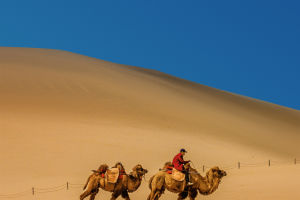Wetlands are the link between land and water and are some of the most productive ecosystems in the world. Rivers are important freshwater habitats across the country as well.
Depending on the type of wetland, it may be filled mostly with trees, grasses, shrubs or moss. Some wetlands, like vernal pools, are actually dry at certain times of the year. Wetlands, rivers and floodplains have many important functions that benefit people and wildlife like providing habitat for a wide variety and number of wildlife and plants; filtering, cleaning and storing water; collecting and holding flood waters; absorbing wind and tidal forces; and providing places of beauty and recreation.
Rivers are important freshwater habitats across the country as well. Salmon and other anadromous fish spawn in the headwaters of rivers and streams and then grow into adults in the ocean before returning to freshwater. These fish provide food for many species and are indicators of healthy rivers.
A wetland is a distinct ecosystem that is flooded by water, either permanently (for years or decades) or seasonally (for weeks or months). Flooding results in oxygen-free (anoxic) Processes prevailing, especially in the soils. The primary factor that distinguishes wetlands from terrestrial land forms or water bodies is the characteristic vegetation of aquatic plants, adapted to the unique anoxic hydric soils.Wetlands are considered among the most biologically diverse of all ecosystems, serving as home to a wide range of plant and animal species. Methods for assessing wetland functions, wetland ecological health, and general wetland condition have been developed for many regions of the world. These methods have contributed to wetland conservation partly by raising public awareness of the functions some wetlands provide.
Types of Wetlands :
1.Marshes
2.Swamps
3.Bogs
4.Fens
Marshes are defined as wetlands frequently or continually inundated with water, characterized by emergent soft-stemmed vegetation adapted to saturated soil conditions. There are many different kinds of marshes, ranging from the prairie potholes to the Everglades, coastal to inland, freshwater to saltwater. All types receive most of their water from surface water, and many marshes are also fed by groundwater. Nutrients are plentiful and the pH is usually neutral leading to an abundance of plant and animal life. We have divided marshes into two primary categories: non-tidal and tidal.
A swamp is any wetland dominated by woody plants. There are many different kinds of swamps, ranging from the forested Red Maple, (Acer rubrum), swamps of the Northeast to the extensive bottomland hardwood forests found along the sluggish rivers of the Southeast. Swamps are characterized by saturated soils during the growing season and standing water during certain times of the year. The highly organic soils of swamps form a thick, black, nutrient-rich environment for the growth of water-tolerant trees such as Cypress (Taxodium spp.), Atlantic White Cedar (Chamaecyparis thyoides), and Tupelo (Nyssa aquatica). Some swamps are dominated by shrubs, such as Buttonbush or Smooth Alder. Plants, birds, fish, and invertebrates such as freshwater shrimp, crayfish, and clams require the habitats provided by swamps.
Bogs are one of North America's most distinctive kinds of wetlands. They are characterized by spongy peat deposits, acidic waters and a floor covered by a thick carpet of sphagnum moss. Bogs receive all or most of their water from precipitation rather than from runoff, groundwater or streams. As a result, bogs are low in the nutrients needed for plant growth, a condition that is enhanced by acid forming peat mosses.
Fens, are peat-forming wetlands that receive nutrients from sources other than precipitation: usually from upslope sources through drainage from surrounding mineral soils and from groundwater movement. Fens differ from bogs because they are less acidic and have higher nutrient levels. Therefore, they are able to support a much more diverse plant and animal community. These systems are often covered by grasses, sedges, rushes and wildflowers. Some fens are characterized by parallel ridges of vegetation separated by less productive hollows. The ridges of these patterned fens form perpendicular to the downslope direction of water movement. Over time, peat may build up and separate the fen from its groundwater supply. When this happens, the fen receives fewer nutrients and may become a bog.


